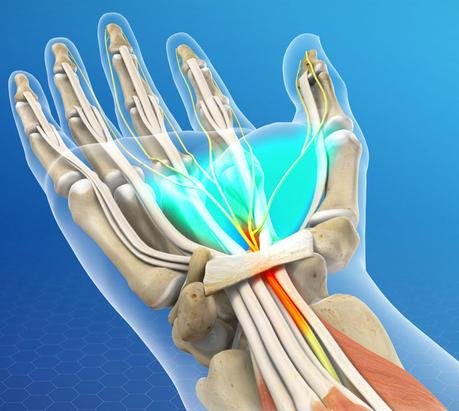Carpal tunnel syndrome (CTS) is the compression of the median nerve in the hand that passes through a canal in the wrist. The median nerve provides sensation in the thumb, index, index finger, and part of the ring finger. This nerve sends impulses to the muscles that go to the thumb. Carpal tunnel syndrome can occur in one or both hands.
Swelling of the wrist causes pressure causing carpal tunnel syndrome or carpal tunnel syndrome. This condition may cause numbness, weakness, and a tingling sensation in the hand near the thumb.
The probability of this syndrome is very high in women between 40 and 60 years old. Pregnant women also experience short-term symptoms of this condition at the end of pregnancy. Women who take birth control pills, are menopausal, or take estrogen medication are more prone to wrist cramps.

Symptoms of Carpal Tunnel Syndrome
The carpal tunnel is a narrow and challenging bony and ligamentous passage in the palm. The median nerve and tendons are located in the carpal tunnel. In some cases, the carpal tunnel may narrow due to inflammation and irritation of the tendons or other swellings that pressure the median nerve.
Sensations in the palm, thumb and three fingers are controlled by the median nerve. The median nerve also controls the muscles that move the thumb toward the palm to touch the other fingers. The pressure on this nerve causes pain, numbness, and weakness in the hand and wrist, which may extend to the arms and even the shoulders. Carpal tunnel syndrome can occur for several reasons. However, if a person moves their wrist frequently, is exposed to vibration, and uses their fingers continuously, such as typing, they are more prone to developing this syndrome. In some cases, carpal tunnel syndrome may not have a specific cause.
It is believed that some common causes of wrist cramp syndrome are:
- Frequent movements and maneuvers
- Frequent use of vibrating hand tools
- work pressure
- Pregnancy, for example, due to edema or fluid retention
- Inflammatory or degenerative joint rheumatism
- Hypothyroidism
- diabetes
- An injury such as a sprained or broken wrist
- Structural problems in the wrist
- Wrist injuries
- A cyst or tumour in the carpal tunnel
- Hyperactivity of the pituitary gland
- Any swelling or inflammation around the tendons
Signs of Carpal Tunnel Syndrome
Symptoms usually develop gradually. Early symptoms are often felt at night or in the morning. Patients may need to shake their hands when they wake up. Discomfort may also cause them to wake up frequently during the night.
The three most common symptoms of carpal tunnel syndrome are:
- Pain
- Numb
- Tingling sensation
These symptoms appear in the thumb and the next finger and half of the ring finger and may extend to the rest of the hand and forearm.
As the disease progresses, symptoms may continue during the day. The person may also lose the power to make a fist and hold small objects in hand. Opening a soda bottle, closing buttons, or typing on a keyboard becomes challenging. If you do not treat this condition, the thumb muscles may fail and the person may lose the ability to detect cold and heat with their fingers. Symptoms worsen after using the affected hand. The burning, tingling, and pain are aggravated, and the arm and other parts of the hand also experience a similar situation.

Diagnosis of Carpal Tunnel Syndrome
To self-examine and diagnose carpal tunnel syndrome, one should gently tap the wrist and check for tingling or numbness in the fingers. Another test method is to bend the wrist or hold it above the head for one minute. If you feel pain, numbness, or tingling, you may have carpal tunnel syndrome. However, these tests do not have definitive results.
A general practitioner usually diagnoses carpal tunnel syndrome after asking about symptoms and examining the hand and wrist for signs of weakness in the muscles around the thumb. Also, how the hands and wrists work is examined and evaluated. Some of the tests that are used in the diagnosis of carpal tunnel syndrome are:
Tinel sign
The doctor gently taps the median nerve to see if the patient feels numbness or tingling in one or more fingers.
Fallen’s sign
The patient squeezes the backs of his hands together to bend his wrists. If he feels numbness or tingling within about a minute, the median nerve in his hand is probably damaged.
Nerve strip
Electrodes are placed on the hand and wrist. Small electric shocks are delivered to the hands. In this test, the speed of message transmission from the nerve to the muscles is measured.
A small needle is inserted into the muscle. The electrical activity on the screen will show whether the median nerve is damaged, and if so, the extent and severity.
Imaging
X-rays show fractures or other disorders such as rheumatoid arthritis. The structure of the median nerve can also be checked with the help of an ultrasound scan. Studies show that MRI is not useful for diagnosing carpal tunnel syndrome.
Physiotherapy for Headache Relief Flat Feet, Symptoms and treatmentTreatment of Carpal Tunnel Syndrome
The goal of treatment is to reduce the symptoms and slow down the progression of carpal tunnel syndrome by reducing the pressure on the median nerve. It is possible for people with mild symptoms to recover without treatment within a few months, especially if they are under 30 years old or the disease happened to them during pregnancy. Various measures can be taken to treat this condition, which will be discussed below:
- Non-surgical treatment
The following measures can help reduce your discomfort:
- Rest your hands and wrists
- Cold compress
- Massage for pain relief
- Stimulus control
If wrist nerve entrapment is caused by repetitive wrist movements, you should rest your hand and wrist and avoid stimulating activities until your hand heals.
- Sport
Two exercises that can help reduce the symptoms of carpal tunnel syndrome are:
Make a fist with the back of your hand facing down. Spread your fingers straight up to the ceiling. Repeat this movement 10 times.
- Open your hand and pull your fingers back as far as you can with the other hand. Repeat this movement 10 times.
- Wrist splint
Although the wrist is kept in one position and it is prevented from bending. These wristbands or splints can be used while sleeping, but if they do not interfere with your daily activities, you can also use them during the day. Wrist splints can be purchased without a prescription. The doctor or pharmacy expert will help you to choose the most suitable type of this wristband.
- Change in daily work
Workplace changes to improve ergonomics or reduce repetitive motions can be helpful. For assembly department employees, these changes include frequent interruptions or work rotation. For office workers, these changes include the use of ergonomic keyboards or special mouse pads. However, there is insufficient evidence that symptoms are reduced by changing computer equipment.
- Diet
Although many of the points mentioned to help reduce symptoms focus on changing external factors, dietary changes also play an important role in reducing symptoms. It is recommended to use vitamin B supplements, and foods rich in magnesium.
The doctor may prescribe corticosteroid injections to reduce inflammation. These drugs are usually injected directly into the carpal tunnel. There are also pills to reduce symptoms, but they are usually less effective. At first, the pain may increase, but after 2 days, it starts to decrease.
If the reaction to the drugs was good, but the symptoms recurred after a few months, the dosage of the drug should be changed. However, the continuous use of corticosteroid drugs is not recommended because of their many side effects.
Non-steroidal anti-inflammatory drugs such as aspirin and ibuprofen also help in the short-term relief of symptoms. If suffering from carpal tunnel syndrome is due to underlying inflammatory diseases rather than frequent use of the wrist, the use of these drugs can be effective.
- Surgery
In severe cases of the disease where treatment measures are not effective and the symptoms remain for more than 6 months, surgery should be performed. Carpal tunnel release surgery, also known as carpal tunnel decompression, is an outpatient procedure that does not require hospitalization. In this operation, the carpal ligament, which is the roof of the carpal tunnel, is cut and the pressure on the median nerve is reduced.
The success rate of this procedure is estimated to be around 90%, and symptoms rarely return afterward. Like any other surgery, this operation may be associated with some complications such as infection, post-operative bleeding, nerve damage, and scarring.

Prevention of Carpal Tunnel Syndrome
To prevent the recurrence of carpal tunnel syndrome, you must follow the principles of good health. Maintain a healthy weight, don’t smoke, and exercise to maintain strength and flexibility. If you suffer from chronic diseases such as arthritis or diabetes, pay attention to your doctor’s recommendations to control your disease.

